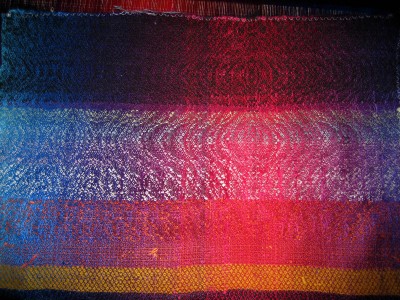I wove a two-stick header, cut the sample off the loom, and wet-finished it. The results are amazing: the black portions (remember that thrift-shop cashmere?) are lusciously soft and thick, the silk (especially the orange silk weft) just glows.
Here is a photo of the sample – I’ve kept this one higher-resolution because in my opinion the closeup really shows off the fabric. It’s too bad you can’t feel it through the website – I’ve been sitting with it next to me because I can’t stop petting it!
The live-tensioned weights worked, and I have cranked up the tension a bit by applying 2 25-lb weights. The only problem I’m having is that the plastic “gear” teeth on the WDL sandpaper beam tend to slip; but I’m going to fix that by sending the sandpaper beam and the cloth beam back to AVL for an upgrade as soon as this piece is complete. Meanwhile, I’m using both sandpaper and cloth beam “gears” so as not to strain either one unduly, and it seems to be working.
I am once again debating what to do. The black cashmere feels SOOOOO luscious that I am tempted to weave it up first; it is also more apt to be forgiving about stuck threads. But the orange is so brilliant that I am tempted to weave up the remaining red-to-orange-to-gold weft first – it’s THAT gorgeous.
Decisions, decisions.


Very pretty! The orange weft will cause iridescence because orange and blue are opposites on the color wheel. Fun to play with the cloth when it does that. A dark rust as weft could be nice.
To study tie-up with this kind of design, start with half 1/3 and half 3/1. That gives a clear reading of the design in threading and treadling. Then modify by changing to 2/2 at transition(s) and/or making more 1/3 than 3/1. If you want to change some shapes, you can move away from a strict twill tie-up, best if done gradually while watching results.
Bonnie Inouye
Tien,
This is beautiful.
Every time I visit your site, I feel small in comparison. You have such talent.